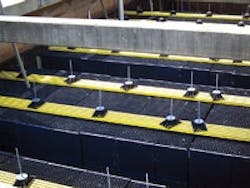IFAS System Triples Nitrification Capacity of TF/SC Facility
The Coldwater Wastewater Treatment Plant (WWTP) in Michigan utilizes a trickling filter/solids contact (TF/SC) process for secondary wastewater treatment. The facility has an average design flow of 140 liters per second (3.2 million gal per day [mgd]) and a peak hourly design flow of 351 liters per second (8 mgd). In August 2007, the Michigan Department of Environmental Quality issued seasonal ammonia discharge limits for the Coldwater WWTP, which included a daily maximum ammonia concentration of 2 mg/L between the months of May and November. The WWTP began to routinely exceed the new limits in the spring and summer of 2008, and as a result, Coldwater began investigating possible upgrades to the facility that would ensure compliance.
Activated Sludge Solution
The existing upstream trickling filters could not be easily enlarged, and expansion of existing aeration basins would have been costly due to high groundwater levels and other constraints. After a comprehensive evaluation, the WWTP found a solution that would integrate submerged structured-sheet media with the existing activated sludge basin footprint, creating an integrated fixed-film activated sludge (IFAS) process to enhance the nitrification capacity of the aeration basin.
Installation began in the first of two parallel aeration tanks in March 2010, with both tanks being fully operational and providing effluent within permit by June 2010. Six media towers were positioned in each aeration basin. Proprietary distribution media was employed in the bottom layer, and high-efficiency fine bubble diffusers were selected. The overall installation was performed by a small crew and was completed within a few weeks.
Efficient Ammonia Removal
At lower loading, nearly complete ammonia removal was accomplished by the IFAS system, while before the IFAS installation, the average ammonia removal efficiency was less than 60% at similar loading. Shortly after the start up, the WWTP began to receive shock loading of industrial discharge, and the unusually high ammonia loads continued for more than a month. As the system was stressed with the high ammonia loading, the IFAS system continued to perform well without being overwhelmed. The highest ammonia removal capacity of 990 lb per day was observed at a loading of 1,606 lb per day with a removal efficiency of 62%. The performance of the IFAS system during this shock load period demonstrated the system’s stability and potential to handle higher loads.
It is estimated that the IFAS system roughly tripled the ammonia oxidation capacity of the solids contact basin. This capacity increase primarily was attributed to the additional nitrification bacteria population attaching to the media. In addition, the engineered aeration system ensures maximized water/air contact and effective biofilm control, which also contributes to the performance increase. The upgraded TF/SC-IFAS process not only is capable of polishing ammonia from trickling filter effluent and consistently meeting the effluent limits, but also is strong enough to withstand prolonged heavy loads and rebound quickly. The engineered
structured-sheet IFAS system proved to be cost-effective and did not significantly change the operational requirements or hydraulic profile of the WWTP.
Download: Here
